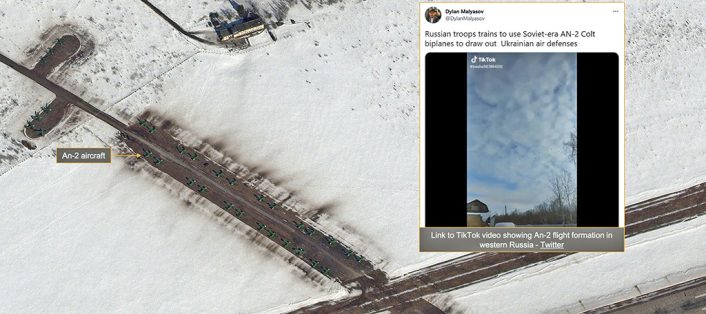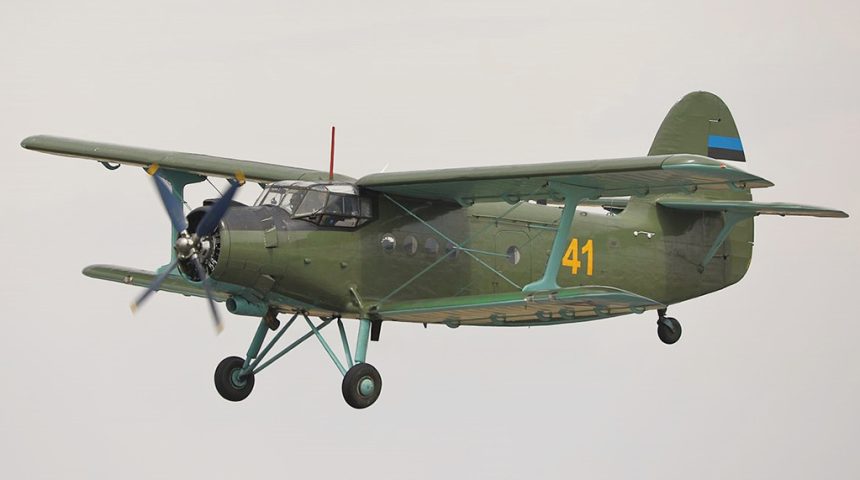Satellite Photos Show Cold War Era Biplanes on Seshcha Airbase Near Ukrainian Border.
In a bizarre move that seems more at home in a Tom Clancy novel, Russia may be preparing to use antiquated Antonov An-2 biplanes, flying unmanned or as drones by remote control, in an effort to draw out Ukrainian air defenses and establish an electronic “order of battle” in preparation for a push into Kyiv.
Satellite photos taken between Feb. 28 and leading up to the past 24 hours show a significant number of Antonov An-2 single-engine biplanes, NATO reporting name “Colt”, at Seshcha Air Base in Dubrovka, Russia. The base is located near the eastern Ukrainian border and was used as a Tu-16 strategic bomber base during the Cold War.
Intelligence analysis provided by Maxar, a private satellite imagery and intelligence think tank company, in their March Situation Report said that:
“Russia has deployed 42 An-2 “Colt” biplanes to Seshcha Airbase in Western Russia. Defense blogger Dylan Malyasov noted in a February 2022 article that Russia had been recently testing An-2 flight formations near the Ukrainian border. The An-2s have likely been converted to drones and could be used as decoys to simulate helicopter or UAV formations to draw out Ukraine’s air defenses. Malyasov note that Azerbaijan employed this strategy against Armenia with great success in the 2020 conflict over Nagorno-Karabakh. Electronic warfare aircraft have also been deployed to Seshcha, joing the combat aircraft deployed in mid-February.”

The report went on to say that, “Additional combat aircraft have been deployed to Shatalovo Airbase in western Russia [just north of Seshcha- ed], which is showing a 3X increase in numbers since early February.”
U.S. Senator Marco Rubio also alluded to the possible conversion of An-2 to drones, citing the same numbers included in Maxar report.
In western #Russia #Putin has deployed 42 An-2 “Colt” biplanes & a 300% increase in combat aircraft
There are indications the “Colts” may have been converted to drones for use as decoys to trigger an air defense response from #Ukraine that would identify their location
— Marco Rubio (@marcorubio) March 2, 2022
The old but still capable Antonov An-2 biplane is well suited to this mission because of its large radar signature and low-speed flight characteristics combined with low cost (read: “expendable”). The An-2, as old as it is in both technology and appearance, is a cost-effective alternative to modern remotely piloted airframes like Russia’s recently tested Inokhodets-RU unmanned aerial vehicle or the older KRONSTADT ORION-E remotely piloted aircraft.
Actually, it’s not even clear how the An-2 drones would be operated by the Russians (provided that the conversion is confirmed): for instance, in the Nagorno-Karabakh theatre, the Azerbaijani biplanes were not really drones (i.e. remotely piloted), but purely unmanned, according to the reports: the pilot took off normally, pointed the aircraft at Armenian positions and then locked the aircraft’s controls using belts. After that the pilot bailed out to safety letting the unmanned plane fly directly towards Armenian units, forcing the enemy troops to open fire thus disclosing their positions.
Anyway, it looks like, as the next round in this dreadful war continues, large numbers of unmanned biplanes over three quarters of a century old might be used in the opening round of an offensive on Ukraine’s capital.









